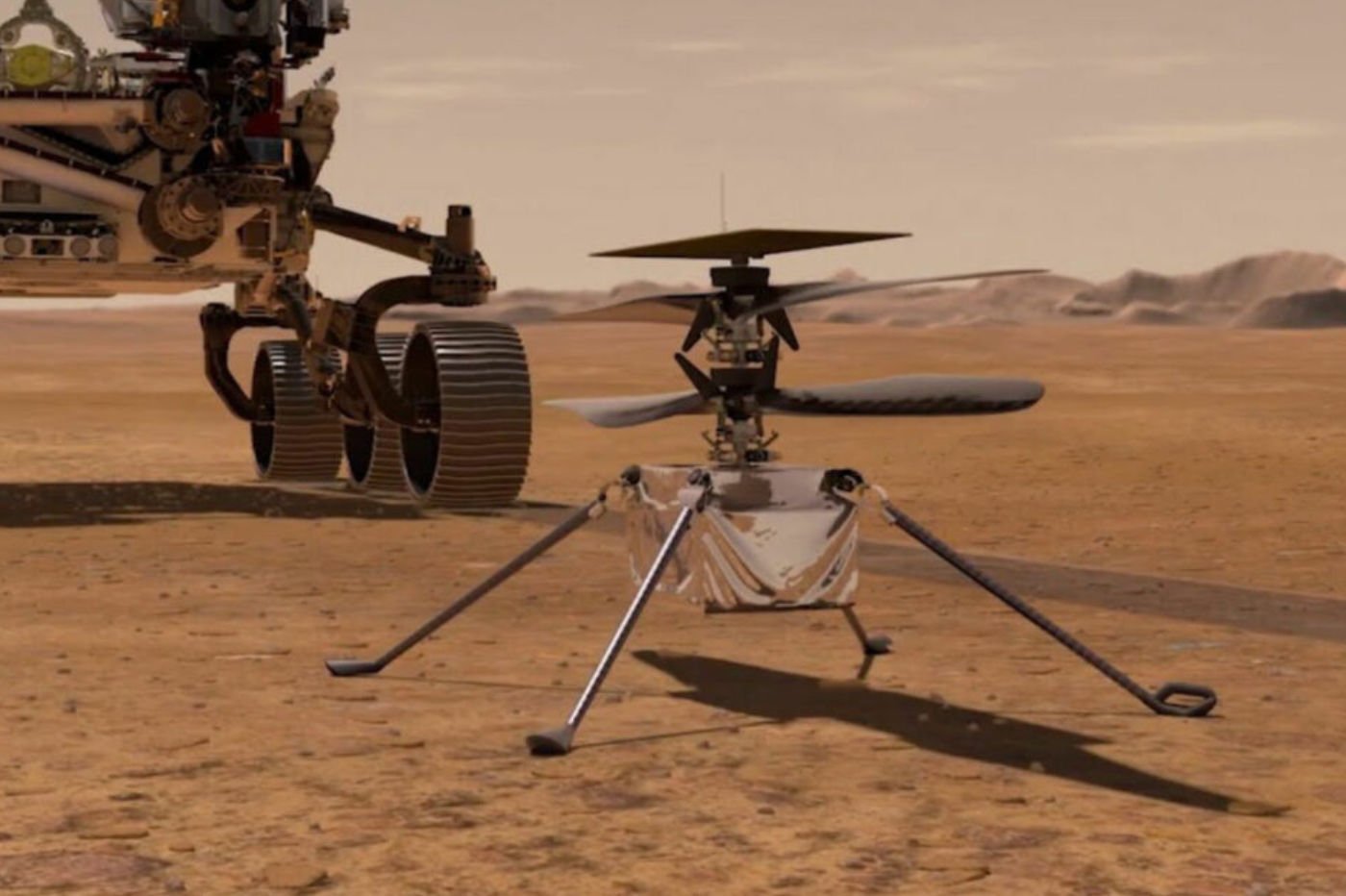The small NASA helicopter offered itself a pilgrimage to the air back to basics by returning to shoot the portrait at the capsule which deposited it on Mars.
On February 18, 2021, the Perseverance rover and its flying companion Ingenuity landed on Mars, marking the start of a fabulous scientific adventure. Very recently, NASA teams were able to remember this day by visiting a rather special stele: Ingenuity went to take a look at the ghostly rubble of the equipment that allowed him and the rover to land safely.
This new expedition, carried out on the occasion of the 26th flight of Ingenuity, allowed the helicopter to capture several great shots. In the middle of the desolate red plains of Mars, we can clearly distinguish the capsule which deposited the two robots. Further on, the rest of the parachute lies on the ground, now half covered with a layer of orange dust.
“Every time it takes flight, Ingenuity offers a perspective that no planetary mission has ever been able to offer.” raves Teddy Tzanetos, chief drone officer at NASA’s prestigious Jet Propulsion Laboratory.
A return to basics full of implications
If these ghostly images of a human device stranded in the middle of this space desert are striking for the public, they are also very important for NASA. Indeed, it is not only a question of a pilgrimage against the background of a return to the sources; if Ingenuity bothered to go there, it’s because the engineers longed to lay eyes on this rubble.
Indeed, this major stage of the 26th flight was carried out at the request of the Mars Sample Return (MSR) engineers. And it’s not just morbid curiosity. As a reminder, this is the mission that will have the difficult task of following in the footsteps of Perseverance to recover its samples, then repatriating them to Earth so that they can be studied (see our article).
The launch of the mission is not expected before the second half of the decade, and it will have to wait 2030 for the return of samples. But until then, the engineers in charge of the program have not planned to twiddle their thumbs. They are already working hard to implement this oh so important mission.
And to maximize their chances of success, every detail counts. In particular, they believe that this rubble will be able to inform them about the specificities of atmospheric re-entry, descent and landing on Mars. This is indeed an extremely delicate step in terms of engineering.

A new look at a critical milestone
To begin with, it is one of the only stages of the mission on which the engineers have not no direct control whatsoever; all they can do is plan for the blow as best they can, and then cross fingers while the vehicle goes through this ordeal alone. During this baptism of fire, he must collect the Dantesque mechanical and thermal stresses that occur when an object hits the atmosphere head-on at more than 20,000 km/hThen Martian surface at more than 125 km/h.
As evidenced by the exploits of the two machines since that date, they finally managed to successfully pass this critical milestone. It therefore represents a example to followand NASA intends to draw inspiration from it to maximize the chances of success of Mars Sample Return.
“Perseverance was the best-documented landing in history, with cameras showing us everything from parachute to contact”, explains Ian Clark, one of the main architects of the rover and the future MSR mission. “But the Ingenuity images give us another point of view.”, he nuances.
“If they confirm that our systems worked as intended, or if they provide us with even a small set of engineering data that can be used to prepare Mars Return Sample, it will be amazing”, hopes the engineer. “And otherwise, the images are still phenomenal,” he breathes. But in any case, we will have to wait several weeks for the engineers to conscientiously dissect all these shots.

Ingenuity still valiant
We should also salute the new performance of Ingenuity, the little helicopter that never ceases to amaze all observers. Remember that originally, he was only supposed to make a maximum of five flights; but this little machine is doing so well that it continues to be put to use.
He recently escorted the Perseverance rover to the famous delta at the border of Jezero crater, where he will now continue his search for traces of past life (see our article); a daunting journey that required great planning effort from NASA. And this 26th flight was of the same ilk.
Indeed, the new theater of operations marks a radical change in the landscape. Gone is the relatively flat terrain over which Ingenuity had been flying all along; now well advanced in the delta, he must deal with very uneven terrain full of small sharp cliffs, hazardous surfaces, dangerous pockets of sand…
So many elements that gave NASA a hard time. “To take the photos we needed, Ingenuity had to maneuver a lot”, explains Håvard Grip, the helicopter’s chief pilot. But it is also there that real geological treasures could perhaps be hidden, starting with the traces of past life that the agency hopes so much to find there. The game is therefore worth the candle; in any case, what is certain is that even if they never find the slightest biosignature, Perseverance and Ingenuity have not finished marveling us.
[related_posts_by_tax taxonomies=”post_tag”]
The post NASA: Ingenuity captures the ghostly ruins of its arrival on Mars appeared first on Gamingsym.
